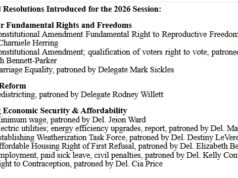by Pete Davis; cross posted from Substack
I just sent off a memo to my state’s Democratic Party leadership (the Democratic Party of Virginia) about how to — in the wake of this year’s loss — begin a transformation from a low-participation, centralized “management party” into a high-participation, broad-based “membership party.” I have posted the memo here — and copied it below, in case anyone might be interested, as it touches on various general themes, including the future of the Democratic Party, the sources of recent Democratic Party electoral failures, and the structures of civic engagement, generally. This memo does not touch on the ideology of the party—however I believe the organizational structure of a party and the ideology of a party are related, and that a commitment to deepening democracy should define both the structure and vision of the Democratic Party (as I lay out in my recent Falls Church News-Press op-ed).
TO: The Democratic Party of Virginia
FROM: Pete Davis (contact@PeteDavis.org)
DATE: December 11, 2021
RE: Transforming DPVA into a participatory membership party
I. From membership to management
As political scientist Theda Skocpol has written in her illuminating book Diminished Democracy: From Membership to Management in American Civic Life, much of civic life in the early twentieth century was based in mass membership organizations—religious congregations, unions, fraternal organizations (like Elks, Kiwanis, Rotary, Jack & Jill, etc.), and political groups (the NAACP, the Sierra Club, the political parties, etc.). These organizations had local chapters (or congregations or union locals) that hosted in-person meetings, managed an annual calendar of real-world events, and worked to be an integral part of the town where they were based. These chapters would federate into state and national conventions and committees. Pairing centralized coordination with deep local participation, this structure allowed local ideas to be transferred to national venues and, in turn, efficiently spread back out to local chapters across the country.
But, as Skocpol points out, American civic life started transforming in the middle of the twentieth century. Mass communication became easier—and civic leaders became enamored with direct-mail fundraising campaigns. As federal politics became more complicated, a class of expert activists who knew the ins and outs of lobbying politicians and mobilizing supporters started growing in Washington and state capitals. National groups started hiring “donor management” and “member relationship” professionals to get the most dollars, votes, and petition signatures out of ordinary people. Eventually, national and state leaders started wondering why they were bothering with all the local pageantry and community-building in the first place. Soon enough, “membership” no longer meant meeting up in local chapters all across the country. It now meant sending checks to expert activists in centers of power in exchange for a bumper sticker, an annual report, and the occasional call to action to do a day of door-knocking or send off a form letter to some elected official.
This transition—from membership to management—shifted civic life. Social groups like post-college fraternities and sororities mostly died off. Groups with an agenda had their local chapters turned into mailing lists. Unions were pacified and demobilized. Religious groups focused more on private piety and less on their role in broader civic life. And political parties that were once-vibrant pillars of local culture became out-of-touch centralized operations that mobilize from afar.
The consequence of this “civic concentration” is the same as its corporate counterpart: More people feel less ownership over public life. A model where everyone volunteers with, participates in, and lends their ideas to a city’s public health system, for example, is one where thousands of people have a relationship with and stake in the success of that system. But when that same health system is managed by an insulated team of experts who only talk with the professional lobbyists from various advocacy nonprofits and corporations, only a dozen or so people take responsibility for its success. You might feel a relationship with your neighborhood if you feel like you co-own it. But if you start to feel like your neighborhood is becoming an administrative unit at the intersection of various indiscriminate flows of action between opaque energy, transportation, housing, and police departments, you won’t be in a relationship with it for much longer.
Martin Luther King Jr. described this as a system that “leaves the person outside”: “the sense of participation is lost, the feeling that ordinary individuals influence important decisions vanishes, and we become separated and diminished.” The political scientist Donald Kettl describes it as viewing the public sphere as a “vending machine”: You put in your votes and tax dollars, and out comes public services. There’s no participation, no interconnectivity, no relationship—and no commitment necessary. A vending machine is also an apt metaphor for the type of control that the system sometimes does give you: You can’t be an owner, but you can be a chooser. You may be separated from the workings of the system by heavy glass, prevented from truly participating in its design, but as a consolation, you can choose among options. As philosopher Michael Sandel writes, our conception of freedom changed from having a “capacity as citizens to shape the forces that govern our collective density” to having a capacity as individuals to choose what we want among a menu of options offered to us by anonymous and inaccessible bureaucracies.
With this shift in public life came a shift in our practice of civic commitment. When public life is something we approach as an active participant—as a co-owner—we experience it as a series of committed relationships: to systems, processes, projects, places, and neighbors. When those shared enterprises struggle in the short term, your relationships keep you loyal over the long term—and even transform your original conceptions of your personal interests and ideals. But when we approach public life passively, as an exercise in selecting among options, we never form those relationships at all. There’s no sense of loyalty to carry us through challenges. When a system fails to meet or understand our interests and ideals, we become angry, alienated, and pacified.
II. DPVA’s loss of a sense of membership
The national Democratic Party, and the Democratic Party of Virginia, has too fallen victim to this civic trend of prioritizing management over membership. Focus has been almost entirely on the endless succession of short-term election campaigns, optimized for the membership that we have at any given time, rather than long-term development of our membership. Most local committees have lost the basic practices of civic organizing: counting and tracking members over time; initiating new members and celebrating old members; building internal community and routinizing internal education and mentorship; formalizing inter-committee learning and strategy dissemination; identifying and cultivating organic local, regional, and state leaders (not candidates, but organizational leaders); building meeting spaces and fostering local committee pride; engaging in the local community outside of elections; mapping territory for recruiting strategy; and more. It’s the equivalent of if a military only fought battles in the short-term without ever, in the long-term, recruiting members, training members, tracking members, cultivating unit pride and culture (through badges, mottos, fables, etc.), identifying and fostering leadership, holding inter-unit meetings to share learnings, having celebrations, or giving out awards. That military would eventually lose out to a military that did the long-term, as well as the short-term, work.
Last month’s election should have been a landslide in the other direction. Half-billionaire private equity mogul Glenn Youngkin is the textbook definition of a plutocrat. He and his party have no serious vision for the future of our Commonwealth except the same economic insecurity, corporate domination, and culture warmongering that they have been trotting out every four years for decades. We can point to various problems in the short run that caused this debacle: candidate choice, the failure to recognize the hardships parents have been through in the past year, the failure to adequately push back against the CRT boogeyman, the federal climate of Congressional gridlock, and even the thermostatic nature of Virginia politics (a blue White House means a red governor’s mansion). However, we would be wise to avoid “fighting the last war”—and instead reflect on the deeper, long-term causes of this failure.
In my view, the long-run challenge revealed last month is that the Democratic Party of Virginia desperately needs to begin a transformation from a top-down, low-participation, centrally-managed party into a federated, participatory membership party. The long-term benefits that such a transformation would bring — more members, more engagement, more routine funding sources, more transparency, more ideas, more leaders, more strategic upgrades, more energy, more sense of shared ownership over our party’s destiny — would overpower any short-term factors against us, like the ones we fell victim to in November. We cannot poll, focus group, consult, data-analyze, or micro-target our way out of this ditch — we will lose the long-term game of fear, spectacle, and money. What we can do is use the tools that got us out of the last Gilded Age: the type of broad-based organizing, engagement, community, and participatory membership that would make real our party’s name.
III. Reviving a spirit of membership in the DPVA: Four areas
Here are four broad areas — symbolized by the “4 Ms” — that could revive our state party’s sense of membership:
(i) Membership Cards
You should actually ‘join’ the Democrats—and we should track how our membership is doing year-over-year. Chairs who are successful at increasing membership should be celebrated and turned into inter-committee mentors and regional leaders — and unsuccessful chairs should be informed and mentored. There should be initiations of new members (with the presentation of a membership card) and celebrations of old ones. New members should immediately be put to work on concrete projects — engagement begats engagement, disengagement begats disengagement. Fundraising should be done primarily through annual membership dues, not sporadic, disrespectful email blasts. Our web infrastructure should drive people not just toward ad hoc volunteer events — but to membership in their local committee. Our famous party leaders should focus less on celebrating extraordinary candidates and more on celebrating ordinary engaged members.
(ii) Maps
We need to split the commonwealth into small precincts and assign every precinct a Democratic precinct captain. Captains should be known by their neighbors as captains because they are so visible organizing the block for the party all year long (not just during election season). Neighbors should see their captains as their first access point to all things politics and government—“when in doubt, ask your precinct captain.” We should track how precinct captains are doing. When precinct captains are successful at increasing general turnout, Democratic turnout, and membership within their precinct, we should celebrate them and learn from them. When they are not successful, we should inform them and mentor them. The most persuasive canvassers during a campaign are people who know you and your community.
(iii) Meeting Halls
Local committee meetings should be designed and executed with utmost care. The party should innovate on and disseminate best practices in making committee meetings, committee working groups, and annual calendars maximally warm and engaging. We should learn from the best practices of other civic groups (from Alcoholics Anonymous to sororities to evangelical churches to the Sunrise Movement) — and create a culture among chairs of sharing learnings and models. Formal rules and procedures should not be fetishized at the expense of engaging ordinary people. Every member should be ready to, proud of, and unconcerned by telling anyone they run into around town: “Hope you can come to our next local Democratic meeting.”
Eventually, each local party should work toward building a physical Democratic Meeting Hall in their district (just like how Elks, Rotary, Odd Fellows, fraternities/sororities, unions, and others have physical spaces). These meeting halls should become warm and lively community centers for the broad progressive, racial justice, climate justice, and labor movement in the area. Wealthy figures and talented fundraisers within the party should be encouraged to think about building such meeting halls across the commonwealth as part of their legacy.
(iv) Mutual Aid
We should directly care for members and for the broader community. Democrats should do disaster relief, take on homeless shelter shifts, attend funerals, send gift baskets when members get married, and bring sick members soup. Effective and inspiring community engagement should be celebrated state-wide — and turned into multi-committee efforts. This is especially important in red districts — trust is earned through real in-person care over the long run, not perfectly-targeted messaging in the short run.
IV. Six steps toward this transformation
Steps toward the transformation will take various forms: top-down from the state party and bottom-up from the local committees; relatively quick steps that could help immediately and relatively long-term projects that will come in fits and starts. Below is a non-exhaustive list of concrete, actionable steps the state party could take this coming year:
Steps toward formalizing party membership and promoting a membership culture:
1. Formalize and track party membership
Currently, the DPVA does not track party membership. It does not have a formal version of state party membership (outside of being members of local committees), it does not have an internal state database of who is a member of any local committee, and it does not have a way of seeing if membership is growing or shrinking as a whole, nor in any particular part of the commonwealth.
As famed organizational theorist Peter Drucker says, “You can’t improve what you don’t measure.” As a foundational step in transforming from a “management party” to a “membership party,” the DPVA should formalize membership in the party, track members in a statewide database, train local chairs in updating the database, and provide dashboards to all party leaders and local chairs for viewing membership counts and trends over time.
2. Push the concept of a “membership culture” through various party institutions
Once membership is formalized and tracked, the party can advance an internal cultural project of normalizing membership as a concept. This could include:
- Issuing membership cards
- Having a formal initiation process for new members in local committee meetings
- Celebrating membership anniversaries (“10 years as a Democrat”) locally and statewide
- Adding members to various “members-only” email listservs
- Establishing sub-party memberships like caucus memberships
- Establishing annual membership dues that are split between local, state, and national parties
- Having the party’s website center membership and drive people to local committee membership
- Co-creating and disseminating local membership apparel (t-shirts, hats, etc.)
- Establishing member-to-member mentoring, training, and leadership development relationships
Steps toward centering chair leadership in membership recruitment and engagement:
3. Establish a formal chair liaison within the state party leadership
If there is to be a transformation of the state party into a membership organization, the key figures in that transformation will be local committee chairs. They are the heart of a membership party — they are the connection between ordinary members and the state party; they are the ones with an ear to the ground about the status of the party in every locale; they are the ones innovating on the routine recruitment, engagement, development, and deployment of party members.
If we are to take seriously this central role of local party chairs, the state party should hire a formal liaison to chairs within state party leadership. This liaison should not only respond to chair requests and disseminate information to chairs—they should also actively develop the leadership of local chairs by gathering and disseminating best practices, celebrating local membership growth, and intervening when local membership is in decline.
4. Create a continual learning community for local committee chairs
There are limits to what state leaders can do, top-down, to transform DPVA into a membership party. In the end, the transformation must be led by local committee chairs, via experiments and innovations at the local level. However, state party leaders can accelerate this bottom-up transformation by creating a continuing learning community among local committee chairs. Put another way, just like how we need to create community within each local committee, community must also be created across and among local committee chairs.
Here are examples of some ways to do this:
- Hold an annual retreat for local committee chairs.
- Initiate new committee chairs at the annual retreat into the community of chairs.
- Hold an annual training (perhaps at the retreat) for local committee chairs.
- Hold a monthly call/Zoom for local committee chairs.
- Create communication channels for local committee chairs — an email listserv, a slack, a newsletter, a knowledge database (to share files, language, FAQs).
- Encourage and facilitate the sharing of learnings among local committee chairs: learnings in recruiting new members, in engaging new members, in meeting design, in broader community engagement, etc.
- Host a leadership development speaker series and/or book club for local committee chairs — bring in civic organizing experts to talk and share studies, for example.
- Create mentorship relationships between novice local committee chairs and experienced local committee chairs.
- Elect a leadership committee among chairs to self-coordinate this community
Steps toward establishing a precinct map and precinct captain program:
5. Create a precinct map of Virginia, recruit captains to fill the map, and develop a precinct-tracking data dashboard
Currently, the DPVA does not have a formal map of all precincts — nor does it push local committees to create their own precinct maps nor recruit precinct captains. This means most canvassing is done ad hoc, by short-term campaigns and super-volunteers. This inhibits the effectiveness of canvassing efforts because many canvassers are strangers who do not deeply know the particular community in which they are knocking. The most effective canvassers remain those with a deep knowledge of and relationships within the community they are canvassing.
The DPVA should transition from ad hoc, short-term, and supervolunteer-driven canvassing to a system reliant on local precinct captains. To do this, the state party should:
- Work with local committees to split the commonwealth into small precincts.
- Work with local committees to recruit precinct captains for each precinct.
- Train precinct captains in the art of precinct captainship. (Captains should be known by their neighbors as captains because they are so visible canvassing the block for the party all year long—not just during election season. Captains should ensure that their neighbors should see them as their first access point to all things politics and government—“when in doubt, ask your precinct captain!” Precinct captains should be responsible for turning out the vote in their precincts, persuading neighbors in their precinct to vote Democrat, recruiting those in their precinct to become members of their local Democratic party committee—as well as recruiting and making use of volunteers to help in this process within their precinct.)
- Create a statewide data dashboard that tracks turnout, Democratic vote totals, and Democratic membership within each precinct, so that precinct captains can track their own progress and party leadership can track the effectiveness of precinct captains (and celebrate or intervene when necessary).
6. Create a training and continual learning community for precinct captains
The most effective way state party leadership can train, develop, and support precinct captains is to create and coordinate a continuing learning community among precinct captains.
Here are examples of some ways to do this:
- Hold an annual retreat for local precinct captains.
- Initiate new precinct captains at the annual retreat into the community of precinct captains.
- Hold an annual training (perhaps at the retreat) for local precinct captains.
- Hold a monthly call/Zoom for local precinct captains.
- Create communication channels for local precinct captains — an email listserv, a slack, a newsletter, a knowledge database (to share files, language, FAQs).
- Encourage and facilitate the sharing of learnings among local precinct captains
- Host a leadership development speaker series and/or book club for local precinct captains — bring in canvassing/organizing experts to talk and share studies, for example.
- Create mentorship relationships between novice local precinct captains and experienced local precinct captains.
- Elect a leadership committee among precinct captains to self-coordinate this community
This is a long-term project — more like the planting of acorns than the planting of sunflower seeds. But we must get to work now — the Virginia Democrats of 2025, 2029, 2033 will thank us. As Martin Luther King often said: “Take the first step in faith. You don’t have to see the whole staircase, just take the first step.”















